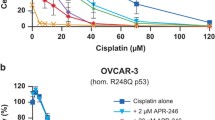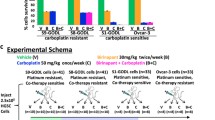Abstract
Advanced epithelial ovarian carcinoma is treated with cytoreductive surgery and combination chemotherapy with a platinum compound and paclitaxel. Despite this treatment strategy, most women eventually relapse and die of resistant disease. Preclinical studies have shown that alterations in drug accumulation, drug metabolism, DNA repair, cellular targets and/or cell survival pathways may cause this resistance. Clinical studies have employed modulators of resistance in combination with chemotherapy as a means to overcome drug resistance. The most extensively studied modulators, buthionine sulfoximine and valspodar, are involved in reversing resistance caused by glutathione and P-glycoprotein, respectively. A phase III study comparing paclitaxel and carboplatin with and without valspodar is ongoing. However, other approaches to overcoming drug resistance are necessary for the effective treatment of women with this disease.
Similar content being viewed by others
References
Greenlee RT, Murray T, Bolder S, Wingo PA: CA Cancer J Clin 2000, 50:7–33.
McGuire WP, Ozols RF: Chemotherapy of advanced ovarian cancer. Semin Oncol 1998, 25:340–348.
Ozols R, O’Dwyer P, Hamilton T: Clinical reversal of drug resistance in ovarian cancer. Gynecol Oncol 1993, 51:90–96.
Coukos G, Rubin SC: Chemotherapy resistance in ovarian cancer: new molecular perspectives. Obstet Gynecol 1998, 91:783–791. This paper provides information on the classic mechanisms of resistance in ovarian cancer. In addition, these authors discuss the apoptotic pathways and the role that molecular alterations in this pathway cause in the development of drug resistance.
Sood AK, Buller RE: Drug resistance in ovarian cancer: from the laboratory to the clinic. Obstet Gynecol 1998, 92:312–319.
Perez RP: Cellular and molecular determinants of cisplatin resistance. Eur J Cancer 1998, 34:1535–1542. A comprehensive review of cisplatin resistance.
Dumontet C, Sikic B: Mechanisms of action of and resistance to antitubulin agents: microtubule dynamics, drug transport, and cell death. J Clin Oncol 1999, 17:1061–1070. A comprehensive review of the mechanisms of resistance in antitubulin agents including paclitaxel.
Andrews P, Howell S: Cellular pharmacology of cisplatin: perspectives on mechanisms of acquired resistance. Cancer Cells 1990, 2:35–43.
Marshall JL, Andrews PA: Preclinical and clinical experience with cisplatin resistance. Hematol Oncol Clin North Am 1995, 9:415–429. Review of the results of preclinical and clinical studies targeted to circumvent cisplatin resistance.
Johnson SW, Ozols RF, Hamilton TC: Mechanisms of drug resistance in ovarian cancer. Cancer 1993, 71:644–649.
Green JA, Robertson LJ, Clark AH: Glutathione S-transferase expression in benign and malignant ovarian tumours. Br J Cancer 1993, 68:235–239.
Hamada S, Kamada M, Furumoto H, et al.: Expression of glutathione S-transferase-pi in human ovarian cancer as an indicator of resistance to chemotherapy. Gynecol Oncol 1994, 52:313–319.
van derZee AGJ, van Ommen B, Meijer C, et al.: Glutathione S-transferase activity and isoenzyme composition in benign ovarian tumors, untreated malignant ovarian tumors, and malignant ovarian tumours after platinum/cyclophosphamide chemotherapy. Br J Cancer 1992, 66:930–936.
Murphy D, McGown AT, Hall A, et al.: Glutathione S-transferase activity and isoenzyme distribution in ovarian tumour biopsies taken before and after cytotoxic chemotherapy. Br J Cancer 1992, 66:937–942.
Ghazal-Aswad S, Hogarth L, Hall AG, et al.: The relationship between tumour glutathione concentration, glutathione S-transferase isoenzyme expression and response to single agent carboplatin in epithelial ovarian cancer patients. Br J Cancer 1996, 74:468–473.
Tanner B, Hengstler JG, Dietrich B, et al.: Glutathione, glutathione S-transferase alpha and pi, and aldehyde dehydrogenase content in relationship to drug resistance in ovarian cancer. Gynecol Oncol 1997, 65:54–62.
Ferrandina G, Scambia G, Damia G, et al.: Glutathione S-transferase activity in epithelial ovarian cancer: association with response to chemotherapy and disease outcome. Ann Oncol 1997, 8:343–350.
Joncourt F, Buser K, Altermatt H, et al.: Multiple drug resistance parameter expression in ovarian cancer. Gynecol Oncol 1998, 70:176–182.
Calvert P, Yao K-S, Hamilton TC, O’Dwyer PJ: Clinical studies of reversal of drug resistance based on glutathione. Chem Biol Interact 1998, 111-112:213–224. Review of rationale and results of many of the clinical studies targeted to circumvent drug resistance based on glutathione.
O’Brien ML, Tew KD: Glutathione and related enzymes in multidrug resistance. Eur J Cancer 1996, 6:967–978.
Reed E: Platinum-DNA adduct, nucleotide excision repair and platinum based anti-cancer chemotherapy. Cancer Treat Rev 1998, 24:331–344. This article details DNA repair and its role in platinum resistance.
Crul M, Schellens JH, Beijnen JH, Maliepaard M: Cisplatin resistance and DNA repair. Cancer Treat Rev 1997, 23:341–366.
Drummond JT, Anthoney A, Brown R, Modrich P: Cisplatin and Adriamycin resistance are associated with MutLa and mismatch repair deficiency in an ovarian tumor cell line. J Biol Chem 1996, 271:19645–19648.
Masada H, Ozols RF, Lai G-M, et al.: Increased DNA repair as a mechanism of acquired resistance to cis-diamminedichloroplatinum (II) in human ovarian cancer cell lines. Cancer Res 1988, 48:5713–5716.
Minotti AM, Barlow SB, Cabral F: Resistance to antimitotic drugs in Chinese hamster ovary cells correlates with changes in the level of polymerized tubulin. J Biol Chem 1991, 266:3987–3994.
Gottesman M, Pastan I: Biochemistry of multidrug resistance mediated by the multidrug transporter. Annu Rev Biochem 1993, 62:385–427. Review of the biochemistry of P-glycoprotein.
Kartner N, Riordan JR, Ling V: Cell surface P-glycoprotein associated with multidrug resistance in mammalian cell lines. Science 1983, 221:1285–1288.
Chen HSL, Bradley G, Thorner P, et al.: A sensitive method for immunocytochemical detection of P-glycoprotein in multidrug resistant human ovarian carcinoma cell lines. Lab Invest 1988, 59:870–875.
Benard J, Da Silva J, Teyssier J-R, Riou G: Overexpression of the MDR1 gene with no DNA amplification in a multipledrug-resistant human ovarian carcinoma cell line. Int J Cancer 1989, 43:471–477.
Arao S, Suwa H, Mandai M, et al.: Expression of multidrug resistance gene and localization of P-glycoprotein in human primary ovarian cancer. Cancer Res 1994, 54:1355–1359.
Noonan D, Beck C, Holzmayer T, et al.: Quantitative analysis of MDR1 (multidrug resistance) gene expression in human tumors by polymerase chain reaction. Proc Natl Acad Sci U S A 1990, 87:7160–7164.
van der Zee A, Hollema H, de Jong S, et al.: P-glycoprotein expression and DNA topoisomerase I and II activity in benign tumors of the ovary and in malignant tumors of the ovary, before and after platinum/cyclophosphamide chemotherapy. Cancer Res 1991, 51:5915–5920.
Holzmayer T, Hilsenbeck S, von Hoff DD, et al.: Clinical correlates of MDR1 (P-glycoprotein) gene expression in ovarian and small-cell lung carcinomas. J Natl Cancer Inst 1992, 84:1486–1491.
Kavallaris M, Leary J, Barrett JA, Friedlander ML: MDR1 and multidrug resistance-associated protien (MRP) gene expression in epithelial ovarian tumors. Cancer Lett 1996, 102:7–16.
Veneroni S, Zaffaroni N, Daidone MG, et al.: Expression of P-glycoprotein and in vitro or in vivo resistance to doxorubicin and cisplatin in breast and ovarian cancers. Eur J Cancer 1994, 30A:1002–1007.
Izquierdo M, van der Zee A, Vermoken J, et al.: Drug resistanceassociated marker lrp for prediction of response to chemotherapy and prognoses in advanced ovarian carcinoma. J Natl Cancer Inst 1995, 87:1230–1237.
van der Zee A, Hollema H, Suurmeijer A, et al.: Value of P-glycoprotein, glutathione S-transferase pi, cc-erb B-2, and p53 as prognostic factors in ovarian carcinomas. J Clin Oncol 1995, 13:70–78.
Kodama J, Hayase R, Yoshinouchi M, et al.: Immunohistochemical analysis of P-glycoprotein expression in diverse histological types of epithelial ovarian tumors. Acta Med Okayama 1994, 48:248–255.
Rubin S, Finstad C, Hoskins W: Expression of P-glycoprotein in epithelial ovarian cancer: evaluation as a marker of multidrug resistance. Am J Obstet Gynecol 1990, 163:69–73.
Bourhis J, Goldstein L, Riou G, et al.: Expression of a human multidrug resistance gene in ovarian carcinomas. Cancer Res 1989, 49:5062–5065.
Bell DR, Gerlach JH, Kartner N, et al.: Detection of P-glycoprotein in ovarian cancer: a molecular marker associated with multidrug resistance. J Clin Oncol 1985, 3:311–315.
Ford J, Yang J-M, Hait W: P-glycoprotein-mediated multidrug resistance: experimental and clinical strategies for its reversal. In Drug Resistance. Edited by Hait W. Norwell, MA: Kluwer Academic Publishers; 1996:3–38. Excellent review of the many modulators of P-glycoprotein-mediated drug resistance.
Rogan AM, Hamilton TC, Young RC: Reversal of Adriamycin resistance by verapamil in human ovarian cancer. Science 1984, 224:994–996.
Jachez B, Nordman R, Loor F: Restoration of Taxol sensitivity of multidrug-resistant cells by the cyclosporine SDZ PSC 833 and the cyclopeptotide SDZ 280-446. J Natl Cancer Inst 1993, 85:478–483.
Ozols RF, Cunnion RE, Klecker RW, et al.: Verapamil and Adriamycin in the treatment of drug-resistant ovarian cancer patients. J Clin Oncol 1987, 5:641–647.
Hendrick AM, Harris AL, Cantwell BMJ: Verapamil with mitoxantrone for advanced ovarian cancer: a negative phase II trial. Ann Oncol 1991, 2:71–72.
Millward MJ, Cantwell BMJ, Lien EA, et al.: Intermittent highdose tamoxifen as a potential modifier of multidrug resistance. Eur J Cancer 1992, 28a:805–810.
Christen RD, McClay EF, Plaxe SC, et al.: Phase I/pharmacokinetic study of high-dose progesterone and doxorubicin. J Clin Oncol 1993, 11:2417–2426.
Miller RL, Bukowski RM, Budd T, et al.: Clinical modulation of doxorubicin resistance by the calmodulin-inhibitor, trifluoperazine: a phase I/II trial. J Clin Oncol 1988, 6:880–888.
van Kalken CK, van der Hoeven JJM, de JongJ, et al.: Bepridil in combination with anthracyclines to reverse anthracycline resistance in cancer patients. Eur J Cancer 1991, 27:739–744.
Germann UA, Shlyakter D, Mason VS, et al.: Cellular and biochemical characterization of VX-710 as a chemosensitizer: reversal of P-glycoprotein-mediated multidrug resistance in vitro. Anticancer Drugs 1990, 8:125–140.
Rowinsky EK, Smith L, Wang Y-M, et al.: Phase I and pharmacokinetic study of paclitaxel in combination with biricodar: a novel agent that reverses multidrug resistance conferred by overexpression of both MDR1 and MRP. J Clin Oncol 1998, 16:2964–2974.
Seiden M, Swenerton SM, Matulonis U, et al.: A phase II study of Incel™ (biricodar, VX-710) and paclitaxel in women with advanced ovarian cancer that is refractory to paclitaxel therapy with or without cisplatin. Proc AACR-NCI-EORTC Intl Conf Molec Targets Cancer Ther 1999, abstract 530.
Baekelandt M, Covelli A, Trope C, Kristensen G: Phase I/II trial of cisplatin and doxorubicin with SDZ PSC 833 in patients with refractory ovarian cancer [abstract]. Proc ASCO 1997, 16:216a.
Fracasso PM, Westerveldt P, Fears CA, et al.: Phase I study of paclitaxel in combination with a multidrug resistance modulator, PSC 833 (valspodar), in refractory malignancies. J Clin Oncol 2000, 18:1124–1134.
Fracasso PM, Brady MF, Moore DH, et al.: Phase II study of paclitaxel and PSC 833 (valspodar) in refractory ovarian carcinoma: a Gynecologic Oncology Group Study. Submitted manuscript.
Fields A, Hochster H, Runowicz C, et al.: SDZ PSC 833/paclitaxel in paclitaxel refractory ovarian carcinoma: a phase II trial with renewed responses [abstract]. Proc ASCO 1997, 16:351a.
Beketic-Oreskevic L, Duran G, Chen G, et al.: Decreased mutation rate for cellular resistance to doxorubicin and suppression of mdr1 gene activation by the cyclosporin PSC 833. J Natl Cancer Inst 1995, 87:1593–1602.
Futscher B, Foley N, Gleason-Guzman M, et al.: Verapamil suppresses the emergence of P-glycoproein-mediated multidrug resistance. Int J Cancer 1996, 66:520–525.
Patnaik A, Warner E, Michael M, et al.: A phase I dose-finding and pharmacokinetic study of paclitaxel and carboplatin with oral PSC 833 in patients with advanced solid tumors. J Clin Oncol 2000, 18:3677–3689.
Perego P, Giarolo M, Righetti SC, et al.: Association between cisplatin resistance and mutation of p53 gene and reduced bax expression in ovarian carcinoma cell systems. Cancer Res 1996;65:556–562.
Liu Y, Bhalla K, Hill C, Priest DG: Evidence for involvement of tyrosine phosphorylation in Taxol-induced apoptosis in a human ovarian tumor cell line. Biochem Pharmacol 1994, 48:1265–1272.
Harris CC: Structure and function of the p53 tumor suppressor gene: clues for rational cancer therapeutic strategies. J Natl Cancer Inst 1996, 88:1442–1255. An insightful review of p53 and strategies for targeting this gene in cancer treatment.
Bauer KS, Rudek MA, Lush RM, Figg WD: Novel targets in cancer therapy: angiogenesis, matrix metalloproteinases, cyclin-dependent kinases, and signal transduction. Highlights Oncol Pract 1998, 16:3–11. An interesting paper on new agents directed against novel intracellular targets currently in early clinical trials.
Dalton WS: Drug resistance modulation in the laboratory and the clinic. Semin Oncol 1993, 20:54–69.
Author information
Authors and Affiliations
Rights and permissions
About this article
Cite this article
Fracasso, P.M. Overcoming drug resistance in ovarian carcinoma. Curr Oncol Rep 3, 19–26 (2001). https://doi.org/10.1007/s11912-001-0038-z
Issue Date:
DOI: https://doi.org/10.1007/s11912-001-0038-z




